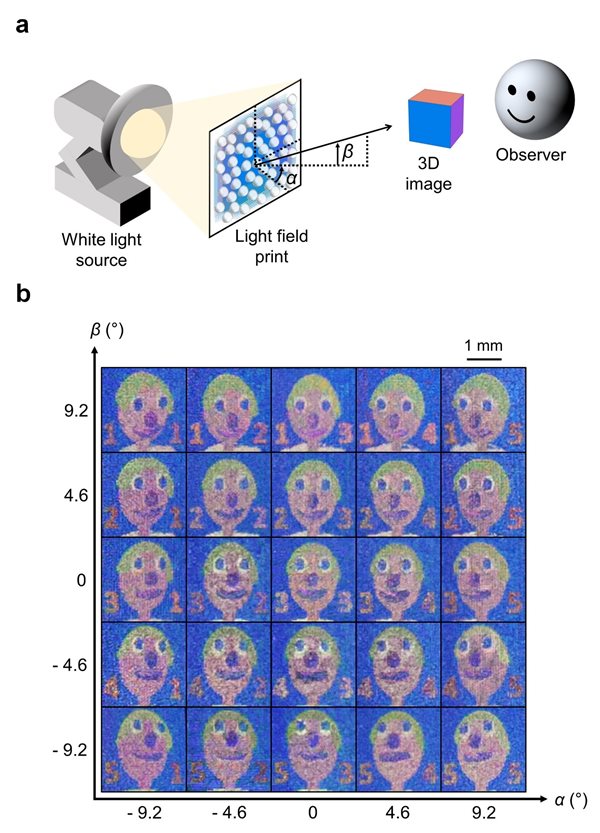╠Ūą─Vlogrchers use nanoscale 3D printing to create high-resolution light field prints
Computer Science, Engineering, Nanotechnology
SUTD –┬ĀJohn You En Chan, Qifeng Ruan,┬ĀHongtao Wang, Hao Wang, Wang Zhang & Joel K. W. Yang
NUS –┬Ā┬ĀMenghua Jiang & Cheng-Wei Qiu
╠Ūą─Vlogrchers have used nanotechnology to create a unique print that displays a glasses-free 3D image under ordinary white light. The appearance of the image changes as the print is viewed from varying angles. The print is called a ŌĆślight field printŌĆÖ for its unique design and appearance as compared to conventional 2D images.
 (a) Schematic of how a light field print works. (b) The light field print observed from different angles.
(a) Schematic of how a light field print works. (b) The light field print observed from different angles.
WouldnŌĆÖt it be amazing if printed images can look three-dimensional (3D)? Unfortunately, conventional prints like photographs display two-dimensional (2D) images with a fixed appearance as they contain only intensity and colour information. These prints are unable to display a 3D image because they lack directional control of light rays, hence resulting in the loss of depth information.
To address this problem, a team of researchers from the Singapore University of Technology and Design (SUTD) used a nanoscale 3D printing technique to create high-resolution light field prints (LFP). The LFP comprises an array of microlenses aligned on top of an array of structural colour pixels. When the LFP is illuminated by ordinary white light, a 3D image is displayed. The 3D image is autostereoscopic, which means that it can be viewed without needing to wear special glasses. The image changes appearance as it is viewed from varying angles, which gives the LFP a special 3D visual effect.
More importantly, high-resolution LFPs are needed to display ultra-realistic 3D images that have potential applications in artworks and security items. By using nanoscale 3D printing to create LFPs, the team achieved a maximum pixel resolution of 25,400 dots per inch (dpi), which surpasses the pixel resolution of consumer inkjet printers ~1,200 dpi. The structural colour pixels in the LFP are made of nanopillars (~300nm diameter). Perhaps the most remarkable result is that each colour pixel can be represented by a single nanopillar to produce the LFP at its maximum resolution.
SUTD Associate Professor Joel Yang, who is the principal investigator of this research, remarked: ŌĆ£This is possibly the first time that 3D printing is used to entirely create a multi-coloured light field print (LFP) in a single step, without the use of dyes, and without the need for manual alignment of microlenses to the colour pixels. The prints are embedded with up to 225 frames within a single LFP to generate smooth viewing transitions at unprecedented resolution. These effects will lead to 2D prints that produce ultra-realistic 3D visuals in future.ŌĆØ
The team anticipates that high-resolution LFPs will become more readily available in the market when nanotechnology allows greater scalability and throughput. This research was published in Nature Communications.
Acknowledgements:
J.Y.E.C. did the experiments and simulations, captured the images, analysed the results, and wrote the manuscript. Q.F.R. assisted in the experiments, simulations, and analysis of results. M.H.J., H.T.W., H.W. and W.Z. assisted in the analysis of results and drawing of schematics. C.W.Q. and J.K.W.Y. supervised the research. All authors edited the manuscript.
Reference:
High-resolution light field prints by nanoscale 3D printing, Nature Communications. (DOI: )
